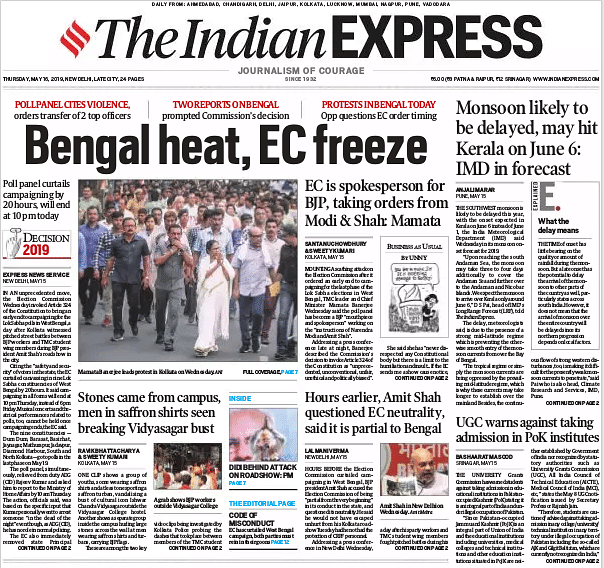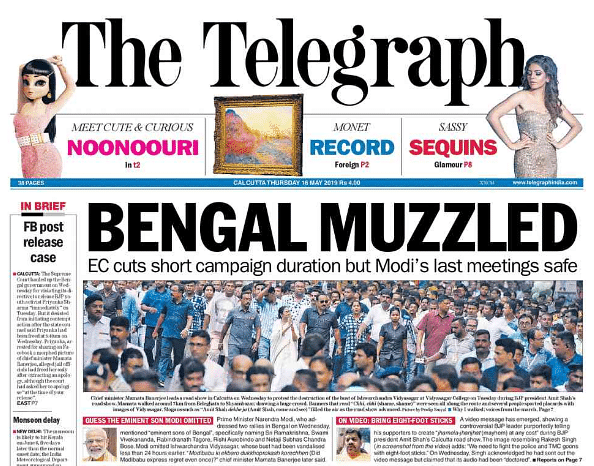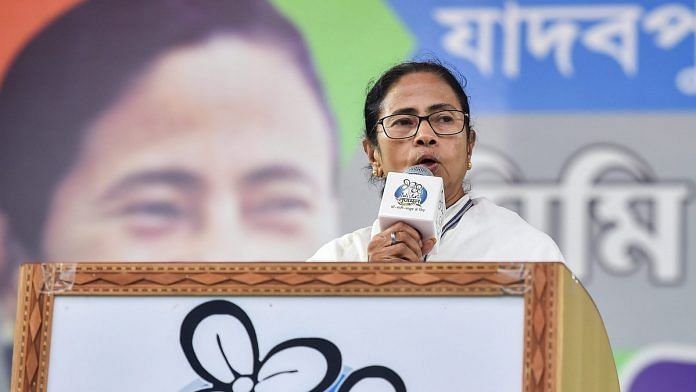Prime Time
BJP president Amit Shah, West Bengal chief minister Mamata Banerjee and footage of clashes in Kolkata: these were the three symbols of the violent conflict in the state that filled the screen on Wednesday .
Shah’s press conference, Derek O’Brien’s counter presser for Trinamool Congress were interspersed with conflicting video shots of the street fights and the “vandalizing” of Ishwar Chandra Vidyasagar’s statue.
By evening, the Election Commission entered the picture ending the campaign in Bengal 24 hours in advance, Thursday 10 pm.
This decision brought out Mamata Banerjee who seized the moment and the microphone to deliver a stinging and often abusive indictment of the EC and the BJP, Wednesday evening.
Her press conference was live at prime time.
In view of the EC’s unprecedented action this was the big story, however, leading news channels across the English and Hindi belts chose not to cover her press conference live in its entirety, only report it. These include, Times Now, CNN News18, News X, ABP News, Zee News, and DD News.
Republic’s Arnab Goswami helpfully offered a translation of Banerjee when she spoke in Bengali and added his own trenchant comments.
CNN News 18’s Bhupendra Chaubey was in Varanasi for an election chat; Times Now in Noida, discussed the violence in Kolkata; Zee News preferred to broadcast a Prime Minister Narendra Modi speech.
Once, Banerjee had delivered her savage sermon, news channels discussed the developments in Bengal.
NDTV India: Anchor Ravish Kumar said, “Only the Election Commission can really say what actually happened in West Bengal”.
He counseled viewers to be very careful about video footage in circulation as it could have been edited.
India Today: Anchor Rahul Kanwal discussed the “high drama in West Bengal”.
BJP spokesperson Narendra Taneja was almost saintly in his viewpoint: “It was Trinamool Congress which instigated the mob. BJP does not believe in violence.”
TMC supporter Manojit Mondal claimed, outrageously and untruthfully, that Amit Shah had been happy when his rally was peacefully completed in Kolkata. He decided to “play the victim card” Wednesday morning only after he heard of the vandalism. However, at “Intellectual’s meeting” after the rally, Shah was seen angrily calling out the media on its coverage of the violence.
Front page
Bengal emblazons front pages for a second day in a row, Thursday — this time the Election Commission is under the headlines’ scanner. Times of India in “In a first, EC cuts short Bengal campaign for Phase 7 by a day” writes “Amid surging threats of violence during the last phase of polls in West Bengal”.
All mainstream newspapers call it an “unprecedented move”, barring The Economic Times, which calls it “a first-of-its-kind decision”. But ET’s headline doesn’t reflect the unique nature of the decision: “Bengal poll campaign cut shot by a day’’.

In contrast, headlines in The Indian Express –“Bengal heat, EC freeze” — and The Telegraph –“BENGAL MUZZLED” – suggest there’s more to the decision: “EC cuts down campaign duration but Modi’s last meeting safe”, writes The Telegraph.

On Banerjee’s criticism of the EC decision, TOI comments “(even) as she protested, Banerjee seemed resigned to the changed situation.”
Another element in Wednesday’s dramatic developments receives less importance –“the EC also ordered immediate removal” of principal secretary (home) Atri Bhattacharya and Rajiv Kumar, additional director-general, CID, for “having interfered in the process of conducting polls by directing WB chief electoral officer…” (ET).
The newspapers are also split on who is responsible for the report that prompted the EC’s decision: The Hindu says, “The Commission said the decision was taken based on a report from the Deputy Election Commissioner in-charge of the State”– Express agrees with that.
The Telegraph, however, writes “the unparalleled pruning of the campaign window came hours after the Union Home ministry took the rare step of writing to the poll panel expressing concern at the electoral violence in Bengal”.
ET says “West Bengal governor KN Tripathi sent a report to the home ministry on the political violence. The report, according to sources, states that the citizens’ fundamental right to free and fair franchise is being violated”.
IMD
Express gives second lead to the India Meteorological Department (IMD)’s prediction of a delay in onset of the monsoon in Kerala. It gives delightful details of the monsoon’s progress from D S Pai, head of IMD’s long range forecast “the tropical regime or simply the monsoon currents are being oppressed by the prevailing mid-latitude regime…’’
HT, which had it as the lead, Wednesday, devotes a column space to “Delayed by 5 days, monsoon will hit Kerala on June 6”.
“IMD has categorised the onset this year to be “slightly delayed”. Hindu adds the prediction is in line with private forecaster Skymet’s estimate that the monsoon will break on June 4.
TOI, cautiously, says “Monsoon…may hit Kerala June 6’’ but that “a delayed (or early) arrival has no impact on monsoon’s overall performance”.
CJI sexual harassment complaint
HT is alone in reporting a piquant situation on Page 1: “Complainant against CJI Gogoi set to file appeal — to the CJI”. It reports that “the former Supreme Court staffer who levelled charges of sexual harassment against Chief Justice of India (CJI) Ranjan Gogoi will soon be filing an appeal, to the CJI himself, against her dismissal from the apex court”.
Opinion
Express in “Code of Misconduct”, squarely blames the Mamata Banerjee government for the violence during the election campaign that led to the “EC’s unprecedented decision to…prematurely end” the campaign in Bengal. “The blame must be necessarily owned by the Trinamool which rules the state,” it writes.
Express traces the history of political violence in the state which didn’t begin with the Trinamool Congress or the Bharatiya Janata Party (BJP): “Congress and the Left used violence to dominate the streets and win elections” in 1960s and beyond. It refers to the “vandalized bust” of Ishwar Vidyasagar as a symbol “of all that has gone wrong with politics” there: he stood for the “rights of the individual over all forms of oppressive collective claims”.
HT in “Why are car sales declining in India”, offers three reasons for the 17.1 per cent drop in sales of passenger vehicular in April — a trend seen since July 2018.
First, “the Indian economy isn’t in the pink of health” — growth figures for the third quarter of FY19 are a mere 6.6 per cent. Second, the automobile industry suffers from “regulatory and policy uncertainties” — India has skipped BS-V emission norms and the Supreme Court has banned the sale of vehicles conforming to BS-IV from 1 April 2020, four years earlier than originally planned. And plans to shift to electric vehicles “doesn’t square with high cost batteries and price sensitive consumers”.
Thirdly, studies in the west show millenials “don’t like owning cars”.
Tweet of the day
Time to wake up, India. This very cult n ideology killed Mahatma and is now behind desecration of the bust of one of the greatest reformers Shri Ishwar Chandra Vidyasagar ji. People of Bengal will give befitting reply to Modi-Shah led perpetrators of violence and hooliganism
— Arvind Kejriwal (@ArvindKejriwal) May 15, 2019
With inputs from Shailaja Bajpai.







Mamta didi ki wattt lagne wali hai ..
Wait 23 may
News reports on 16 May , 2019 say that EC had to cut short the campaign time in West Bengal for political parties in view of incidents of violence . It seems the EC invoked related Constitutional provisions in that regard. In this context , it may be apt to refer to this Vedic astrology writer’s alerts for more care and appropriate strategy in article – “ The Year 2019 Astrologically for India” – published last year on 7 October , 2018 at theindiapost.com. The related text of predictive forecasts for the period February -March and around in 2019 reads like this in the said article :-
“ All that is associated with the sovereign power of State appears to be on the centre –stage”.
Obviously , when Constitutional provisions are coming to focus for dealing with an unprecedented situation , it can be construed to be exercise of sovereign power of State. Later and separately , this writer has also mentioned that a period of four months and a half from mid -April to August , more so June , in 2019 looked to this writer having potential to give rise to worrisome concerns in vulnerable countries of world including India. More care and appropriate strategy can be meaningfully tapped to deal with the situations that may likely emerge. These alerts were indicated through article – “ World trends in April to August 2019” – brought to public domain widely in March and on 5 April 2019.